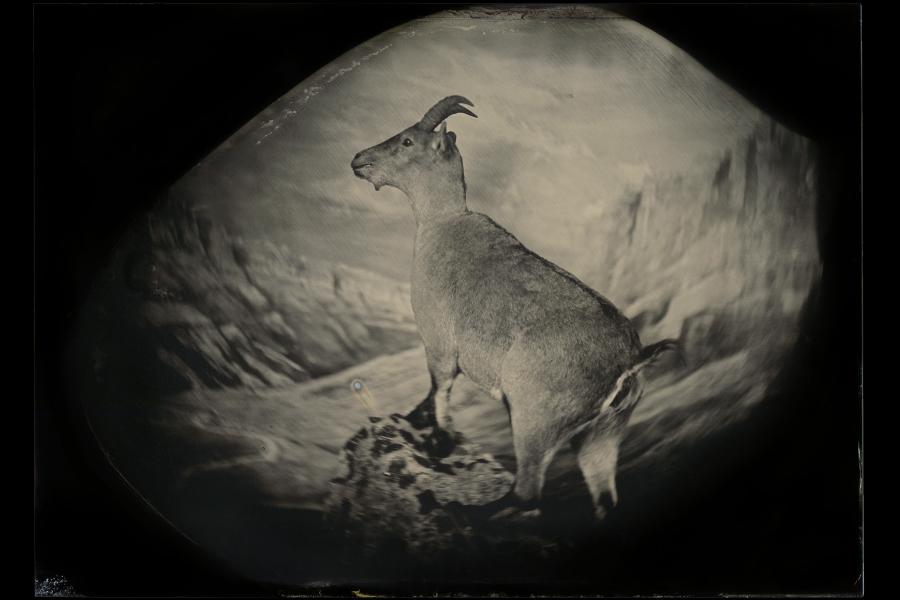Ibex, ‘Resurrection Tintypes’, 2012, Robb Kendrick

Species: Pyrenean ibex (Capra pyrenaica pyrenaica)
Location and habitat: Pyrenees Mountains
Conservation Status: Extinct
Title: 'Resurrection Tintypes'
Creator: Robb Kendrick
Date: 2012
Medium: Tintype photograph.
Copyright: Used with permission.
Photographer Robb Kendrick set his ancient camera upon a taxidermied goat in a visitors centre located on the edge of a national park in Spanish Pyrenees Mountains. He captured the above image via a tintype photo, a technique popular in the mid-19th Century that creates a direct positive of an image on a thin sheet of metal, coated with enamel and photographic emulsion. Robb used this almost-extinct photographic techinque to capture this image of the extinct Pyrenees Ibex. For millennia, these Ibexes lived in the ruggard mountains that separate Spain and France, their hooves clinging impossibly to cliffs and their teeth cutting through tough vegetable matter as they went about their alpine goaty ways. This was until the 19th Century, when hunting saw the once abundant population collapse, with only a dozen members of the species left by 1989. Only a single female made it 6 days into the 21st Century, the 'endling' known as Celia, who was found crushed by a fall tree and promptly taxidermied and put into the vistor's centre.
As if the total demise of the Pyranean Ibex was not enough, Spanish scientists decended on Celia's lonely death, extracting some still-living cells before handing her over to the taxidermists. Three-and-a-half years later, variation-on-a-theme headlines rung out calling the Pyreneen Ibex 'the first animal to go extinct twice'. Following the same technique as led to Dolly the Sheep (5/7/1996-14/2/2003), the most famous animal clone, laboratories in Zaragoza and Madrid grew Celia's cells in dishes. They then extracted the cell's nuclei and injected them into emptied out goat egg cells; shocking them with an electric current -- Frankenstein style -- before implanting them into the uteruses of surrogate mothers. Scientists repeated this process with 57 implantations resulted in seven mother's becoming pregnant, six of which ended in miscarriages. One finally carried a kid to term, which was removed by cesarean section. The baby clone's lungs were completely malformed, leaving the newborn kid gasping wretchedly and it was dead within ten minutes. The team celebrated this as the world's first act of 'de-extinctioning' (see the entry on the thylacine for more on this).
The National Geographic article, that commissioned the striking tintype photograph above, concluded with a discussion with bioethicist Professor Hank Greely who gave his thoughts on Celia, and the potential 'de-extinction' of other species. Greely concluded: "What intrigues me is just that it's really cool [...] A saber-toothed cat? It would be neat to see one of those". It is disquieting to note that the Director for the Center for Law and the Biosciences and Chair of the Steering Committee of the Center for Biomedical Ethics at the prestigious Stanford University essentially takes a Silicon Valley 'gee-whiz' approach to bio-tech. The extinction crisis, and the bio-tech reconstitution of life, set the stakes considerably higher than can be measured in units of 'coolness'.
Quotes
No quotes found.
Login to add a quote


